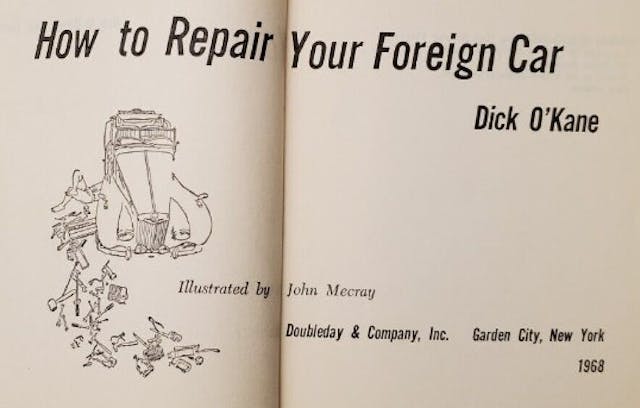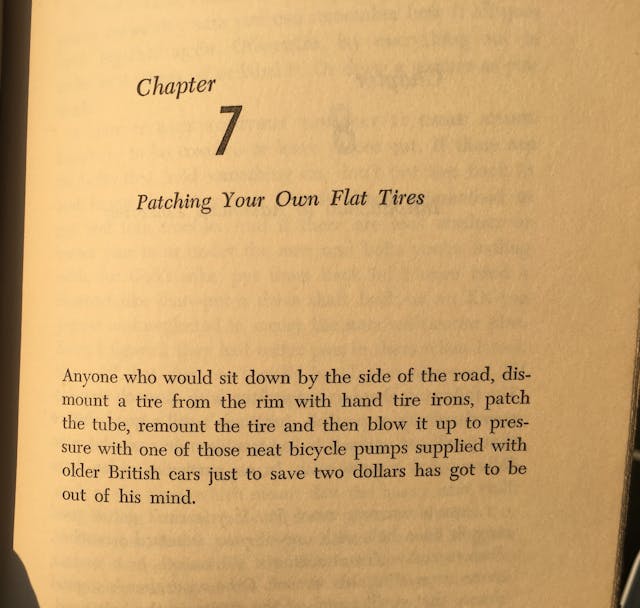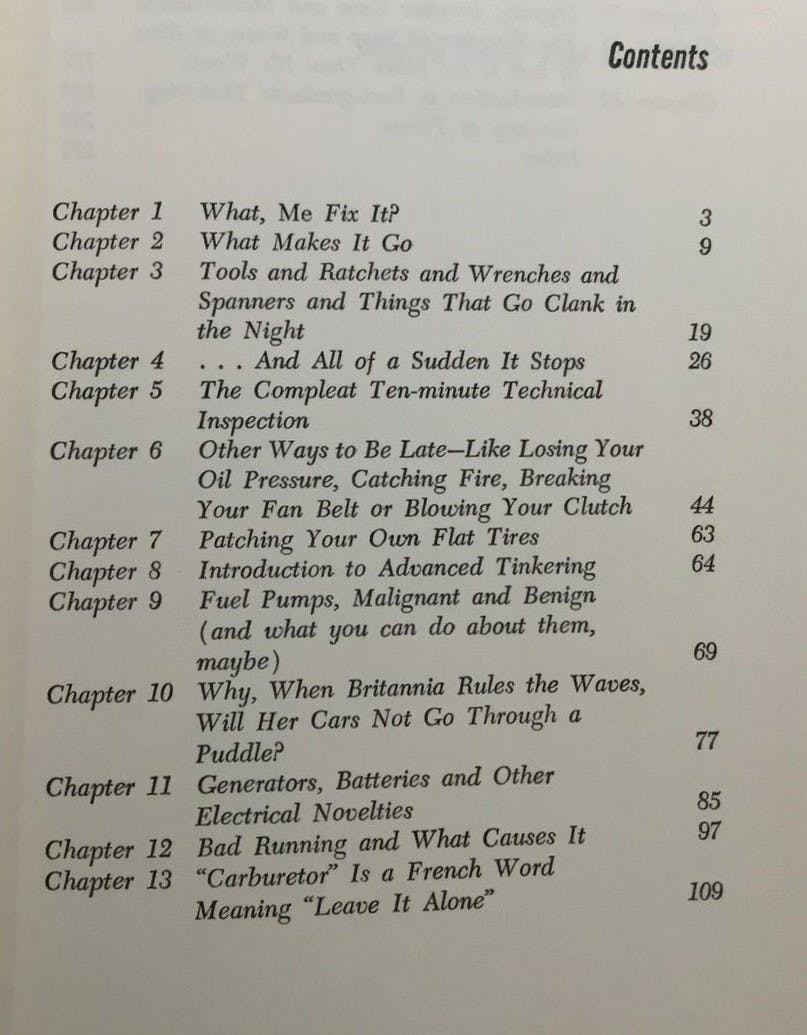A new review of an old book that you may want in your library

I recently had to spend a day in a hospital waiting room while a family member underwent a procedure (they’re fine). I took some unusual reading material with me—How To Repair Your Foreign Car: A guide for the beginner, your wife, and the mechanically inept by Dick O’Kane (Doubleday, 1968). A friend bought it for me five years ago, and I hadn’t gotten around to reading it. I thought something light would be a good counterpoint to the gravitas of the hospital.
Let me back up a bit. The three books that most influenced me as an automotive writer were Zen and the Art of Motorcycle Maintenance by Robert Pirsig, How To Keep Your Volkswagen Alive: A manual of step-by-step procedures for the compleat idiot by John Muir, and Shop Class as Soul Craft by Matthew Crawford. I read Zen when I was in college 45 years ago, and like many young men overly impressed with their own intelligence, loved its odd epistemological ramblings and its tenet that working on a motorcycle is a microcosm of rationality itself. I re-read it when I was writing my first book, Memoirs of a Hack Mechanic, and was surprised by how badly it (or I) had aged. What were mind-blowing Carlos Castaneda-like revelations when I was 18 on the metaphysics of quality now struck me as a self-indulgent series of digressions; the chapter on “stuckness” that I remembered so fondly was a joke; and there was but a single diagnostic example of the kind of Zen-based maintenance that forms the book’s title (the author realized that his bike was running rich at high altitudes and leans it out).
In contrast, the “Idiot Manual,” as John Muir’s Volkswagen book is usually called, really is the “philosophy lesson disguised as a repair manual” that Zen pretends to be. Muir really does dispense hippie-cowboy-Zen wisdom, sort of an automotive version of Sam Elliot’s character in The Big Lebowski. His book was a huge entry point for me into both wrenching and writing. It’s what got me working on my then-girlfriend’s (now wife’s) VW bus in the late ’70s. The idea that a real repair manual can be written in the first person and be entertaining enough to read cover to cover was the inspiration for my book Just Needs a Recharge: The Hack Mechanic Guide to Vintage Air Conditioning.
I thought that Matt Crawford’s Shop Class as Soul Craft bogged down after it came out of the gate, but the third chapter, “To be master of your own stuff,” hit the nail on the head in terms of why it feels so damned good to fix things yourself. I’ll freely admit that I thought, “Well, if he can write about this, so can I” when I was collecting similar themes I’d been writing about for decades for BMW CCA Roundel magazine, and I used them as the basis for Memoirs of a Hack Mechanic.
Then, when I began writing Memoirs, I discovered a fourth book—Old Tractors and the Men Who Love Them: How to keep your tractors happy and your family running, by humorist and CBS Sunday Morning correspondent Roger Welsch. As per the subtitle, this wonderful book delved into the relationship between hobbies/passions and human connection.
To be clear, How To Repair Your Foreign Car hasn’t worked its way in as a fifth face on this automotive literary Mount Rushmore. But it’s a charming little book that’s a decent primer on how to troubleshoot common problems on your vintage car, foreign or otherwise. And, in more than a few places, it’s laugh-out-loud funny.
The author, Dick O’Kane (1936–2019), was a print and television copy writer. How To Repair Your Foreign Car was the first of his eight automotive/mechanical books. Mr. O’Kane had such an endearing gift for flippant names and phrases that you’d assume he was British (he was from Arkansas and Rhode Island). For example, his term for a generic British car is “Trashwell-Snailby,” and when it breaks, you have to take it to “Filth & Greed Motor Imports Ltd.” The sound of a fan belt snapping is “THWOMPETYbangbangbang CLUNK!” Really, the tone of the entire book is contained in the chapter, “Why, When Britania Rules the Waves, Will Her Cars Not Go Through a Puddle?”

Mr. O’Kane’s book is an entertaining readable narrative in which he applies simple common-sense diagnosis and repair to the things that are most likely to be the causes of a car dying or not starting, and offers that if it’s not these things, it’s something more serious and you’ll need to pay for a tow and a repair. There is an appealing economy and clarity in that approach. The neat thing is that his list lays directly on top of the first six of what, for decades, I’ve written about as “The Big Seven” things likely to strand a vintage car (ignition, fuel delivery, charging, cooling, belts, clutch hydraulics, ball joints). The mind-blowing part is that it’s one thing for me to be applying this to the bulk of little “ferrin” cars from the European invasion of the late ’60s and early ’70s that are now 50 years old, and quite another to find the same set of common problems described in a book from 1968 when the cars were nearly new. Although most cars from this era are similar (that is, carbureted and free of emission controls), the “foreign” part of it is there because it was the author’s passion, and it provides a nifty foothold to describe what probably did happen a lot back in the day—if you took a Beetle or a Porsche into a corner service station where the mechanic was used to servicing Chevys and Fords, he’d be flummoxed not only by it not being ’Murican but by the engine being at the wrong end.
The book begins with a “What Makes it Go” chapter, which is quick primer on engines and the suck-squeeze-bang-blow four-stroke cycle, followed by “And All of a Sudden It Stops,” in which car-dies-while-running problems are, as you would imagine, triaged primary as fuel or ignition related (unless they’re accompanied by a large, expensive bang). O’Kane quickly has you examining battery terminals, looking for broken ignition wires, checking for spark, and verifying that the fuel pump is pushing fuel into the carburetor, giving just the right amount of detail for a first troubleshooting encounter if you’re not naturally a grease-under-the-nails person. Subsequent chapters drill down into ignition, fuel delivery, cooling system, charging system, the clutch, and the distinction between car-dies-while-running and car-won’t-start. It’s a good approach. He swims in the old-school waters that rough running is almost always an ignition-related problem, and that “carburetor” is a French word meaning “leave it alone.” Of course, when the book was written, it wasn’t yet old school.
O’Kane seems to get genuine enjoyment out of describing bashing things with a hammer—voltage regulators, SU electric fuel pumps, starter solenoids. This, of course, makes for great writing, and fits with the quintessential experience of driving your, ahem, Trashwell-Snailby in the rain when the car dies. The common thread with these devices is that they contain electromagnets with contact points, and if they’re stuck, a little mechanical persuasion sometimes helps them open or close. I wish that he’d drawn the common thread connecting them, but he is forgiven because his description of the three states of operation of the voltage regulator is perhaps the clearest I’ve seen anywhere.
Given that it’s a 55-year-old book, there are, of course, anachronisms. I laughed every time I read that working on the car yourself would save you from paying the $7-an-hour labor rate at the dealership, or that certain technical questions could be answered by your “dealer shop manager.” More serious is the fact that he says you can check for spark at a plug wire by simply holding it in your hand while someone cranks the engine. This is horrifying. Coil voltages have crept up significantly over the years, and any spark testing should be done by holding the plug connector ¼-inch from ground with insulated pliers.
Furthermore, if the car suddenly dies, O’Kane is correct in telling you to look for broken ignition wires at the ignition coil, but he omits the simple description that the wire to the coil’s “+” terminal should be carrying battery voltage, and the wire on the “-” terminal should connect to the condenser on the distributor. Then again, this is in keeping with the “ferrin car 101” nature of the book; there aren’t scary-looking wiring diagrams anywhere. And the instruction that, if a car is overheating, the stuck-closed thermostat should be removed, is a bit too 1968 to be useful. Yes, thermostats can stick closed, but not all of them can simply be removed. And the stuck-thermostat trope is usually false; hot-running on old cars is almost always due to insufficient heat transfer (clogged radiator) and insufficient air flow (fan and shroud).
But this is just quibbling around the edges. It’s astonishing to me that a concise little book written 55 years ago about troubleshooting and repair of lightly-used foreign cars could still be so close to the mark and be such a joy to read. Not every page contains humor, but when I read the single-sentence chapter on “Patching Your Own Flat Tires,” I laughed so hard that other people in the waiting room began looking at me. And the chapter on “Dignity: Routine Care and Maintenance,” which gives you creative ways to lie about the fact that your precious foreign car is actually dead by the side of the road, is a whole new comic vein that I intend to mine.

I deeply regret that Mr. O’Kane and I never crossed paths, shared libations, and swapped stories before his passing in 2019.
If you have a friend or loved one who is into simple old cars, be they foreign or domestic, and enjoys good writing, hunt down a copy of Dick O’Kane’s How To Repair Your Foreign Car (used copies are available through Amazon vendors). Then wait for the laughter. And for them to bash their voltage regulator with a hammer.
***
Rob’s latest book, The Best of the Hack Mechanic™: 35 years of Hacks, Kluges, and Assorted Automotive Mayhem, is available on Amazon here. His other seven books are available here on Amazon, or you can order personally inscribed copies from Rob’s website, www.robsiegel.com.
Check out the Hagerty Media homepage so you don’t miss a single story, or better yet, bookmark it. To get our best stories delivered right to your inbox, subscribe to our newsletters.




This sounds like a book that will go onto my “wish list” for Christmas or my next birthday. I might even take it with me to my next visit to a waiting room to read 😏.
I was a student of both VW idiot books–there was one for Rabbits too–in the early 80’s when I was in my intensive maintenance period with both first year carb Rabbit and first year pancake dual carb 72 Bus (and didn’t have a garage for the inevitable Bus engine rebuild). My first new car–84 Honda CRX–cured me of VeeDub disease. Haven’t owned a VW product since 85….sounds like the new ones aren’t that much different. Now I have an MB–and they are worse!!!!! Zee Germans are too schmaart! Overengineering can make things break..
I bought a VW about 1970 and not even able to spell vw I sent the engine to be rebuilt. Got it back and was driving to a SCCA meeting when it made “funny” noises and quit. I said my Sunday school lesson and sold it.
But, I have driven Elvas (street and race) for over 60 years, so who I to talk?
Back in the day, I HAD this book, and praised it to anyone who might be assisted by it.
Some lines still resonate in my memory: “Buddy, if you smell gasoline…”
Rob, I’m shocked that you hadn’t read it earlier, but very glad that you’ve now made so many readers aware of it.
Your Waiting Room experience reminds me of the time I was in the checkout line in a bookstore, and started reading the book I was purchasing — by Dave Barry. People actually started backing away from me.
For a period of time, Dave Barry was the funniest writer on the planet. I’ll never forget his column on preping for a colonoscopy. “MoviPrep is a nuclear laxative. I don’t want to be too graphic, here, but… Have you ever seen a space-shuttle launch? This is pretty much the MoviPrep experience, with you as the shuttle.”
Try Patrick McManus…
I bought a VW about 1970 and not even able to spell vw I sent the engine to be rebuilt. Got it back and was driving to a SCCA meeting when it made “funny” noises and quit. I said my Sunday school lesson and sold it.
But, I have driven Elvas (street and race) for over 60 years, so who am I to talk?
In 1971 when I was a high school senior, it was this book that convinced my dad I could do the maintenance on the “Thrashwell-Snailby” we decided to purchase as a high school shop project for me. In reality, the car is a 1967 S1 OTS Jaguar E-Type bought for cheap, and I am still the fortunate owner of both it and the book. HTRYFC got me through easy and inexpensive tuneups (no timing light needed!), emergency SU carburettor and fuel pump fixes, fan belt changes, clutch maintenance and more on two cross country road trips and three years of college. So pleased you found this book, @robsiegal. It brings back all the memories of over 50 years with my pride and joy at the ripe young age of 70.
Keep reviewing old books! love it.
I also was impressed with Zen & the Art… in high school and can’t even read it now.
The others I would welcome more detail about.
Great article. I went to my office right after reading it and grabbed my own battered and dog-eared copy, bought soon after publication from the venerable old “Classic Autobooks”. Tinkerers dream book for a kid with a new DL and a ‘61 Valiant. Years later, I used the beer-can exhaust repair trick on p. 141 to get me through an SCCA race weekend (plenty of beer cans handy….).
O’Kane was a terrific writer, I believe he even wrote for some of the long extinct car magazines back in the day.
Keep ‘em coming!
Dick O’Kane wrote a few Hilarious stories in Road and Track back then. Perhaps politically incorrect, they still tickle me, all these years later.
I was a kid reading O’Kane in Road&Track magazine at about this time… I recall him writing “ until she found out that riding in an old Porsche was exactly like going to Hell in a Waring blender….”
I still have my copy of O’Kane’s book, bought new when it first came out in 1968. I was learning maintenance and repair on one of the less reliable nameplates (Renault), and how to deal with everything’s-hard-to-reach-except-the-carburetor-and-generator, which rarely need attention, on my wife’s VW Beetle. And doing some maintenance–for (to quote Dave Barry) actual money–on a neighbor’s dilapidated Trashwell-Snailby–cleverly disguised as an MG-TD.
I periodically re-read chapters just for the laugh quotient, particularly after I’ve had a frustrating session with a recalcitrant bolt, unexplainable ignition glitch, or a carburetor that just doesn’t want to play nicely with gasoline and air.
Rob, eloquent wrench twister that you are, I’m amazed it took you this long to find and read Dick’s book, and glad you did.
The irony is that today we are likely LESS prepared for a breakdown than we were then. Cars are so darn reliable that I’d guess many people have never had to deal with anything more complex than gas, battery, or tires. Because of this, the repair infrastructure out there is functionally non existent. I got to think about this last Saturday, as I kept my dead Honda company on the side of a rural road. Fun fact: Cops can find a tow in 20 minutes, while the auto club takes hours. Oh, and it WAS the carburetor.
Dear Hack: After reading this article, I immediately checked Amazon. They have exactly one used copy for $123.52. I guess I will pass, but will keep looking. There is a great used book store in my neighborhood.
I think Hagerty readers are buying them up. Yesterday when I read this article, Abe Books had a $15 copy and a handful in the $20-$35 range. I bought the $15 copy but still haven’t gotten confirmation that they will fulfill the order. Someone may have beat me to it. Today the cheapest one on Abe is over $100.
Yes. You guys are on to me. *I bought all the existing copies before I published the piece and now am cleaning up. This is the Hack Mechanic version of “pump and dump.”
Maybe some enterprising person will make a pdf of the book available? Hint.
Well I’m in luck. The seller on Abe confirmed the $15 order and it’s in the mail on the way.
I knew a guy who patched / changed tires in his garage. The HOA was not amused with his fireworks.
I bought O’Kane’s book when a 9 year old MG A was my daily driver. In addition to making me laugh out loud, the book taught me a great deal about keeping the car running. Since then, I can’t count how many times I’ve heard the phrase “carburetor is a French word for leave it alone” at car shows. I still have the original oil stained (Duckhams of course) book, would never part with it. I’m surprised Rob got this far into the car hobby (addiction) without running across it.
I very much enjoyed Matt Crawford’s Shop Class as Soul Craft and certainly was persuaded by his description of the rewarding nature of mechanical repairs, and his advocacy for an education system that prives high school students with opportunities to learn a trade consider paths other than college and desk-bound work.
Agree totally.